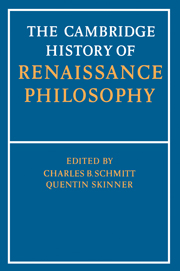Book contents
- Frontmatter
- Introduction
- PART 1 THE INTELLECTUAL CONTEXT
- 1 The conditions of enquiry: Manuscripts
- 2 The conditions of enquiry: Printing and censorship
- 3 The Renaissance concept of philosophy
- 4 Translation, terminology and style in philosophical discourse
- 5 Humanism
- PART 2 PHILOSOPHY AND ITS PARTS
- PART 3 SUPPLEMENTARY MATERIAL
- Biobibliographies
- Bibliography
- Index nominun
- Index rerum
- References
5 - Humanism
from PART 1 - THE INTELLECTUAL CONTEXT
Published online by Cambridge University Press: 28 March 2008
- Frontmatter
- Introduction
- PART 1 THE INTELLECTUAL CONTEXT
- 1 The conditions of enquiry: Manuscripts
- 2 The conditions of enquiry: Printing and censorship
- 3 The Renaissance concept of philosophy
- 4 Translation, terminology and style in philosophical discourse
- 5 Humanism
- PART 2 PHILOSOPHY AND ITS PARTS
- PART 3 SUPPLEMENTARY MATERIAL
- Biobibliographies
- Bibliography
- Index nominun
- Index rerum
- References
Summary
THE MEANING OF HUMANISM
Humanism was one of the most pervasive traits of the Renaissance, and it affected more or less deeply all aspects of the culture of the time including its thought and philosophy.
Humanism has been described and interpreted in many different ways, and its meaning has been the subject of much controversy, just as has been the concept of the Renaissance itself. Whereas the term ‘humanism’ in current discourse often denotes an emphasis on human values unrelated to any intellectual or cultural traditions, Renaissance humanism was understood and studied by most historians of the nineteenth and early twentieth centuries as that broad concern with the study and imitation of classical antiquity which was characteristic of the period and found its expression in scholarship and education and in many other areas, including the arts and sciences. The modern term ‘humanism’ has been used in this sense since the early nineteenth century and was derived from the term ‘humanist’ coined in the late fifteenth century to designate a teacher and student of the ‘humanities’ or studia humanitatis. The word ‘humanity’ and its derivatives were associated with a ‘liberal’ education by several Roman writers, especially Cicero and Gellius. The term was revived by Petrarch, Salutati and others in the fourteenth century, and by the middle of the fifteenth century it came to stand for a well-defined cycle of studies, called studia humanitatis, which included grammatica, rhetorica, poetica, historia and philosophia moralis, as these terms were then understood. Unlike the liberal arts of the earlier Middle Ages, the humanities did not include logic or the quadrivium (arithmetica, geometria, astronomia and musica), and unlike the fine arts of the eighteenth century, they did not include the visual arts, music, dancing or gardening.
- Type
- Chapter
- Information
- The Cambridge History of Renaissance Philosophy , pp. 111 - 138Publisher: Cambridge University PressPrint publication year: 1988
References
- 11
- Cited by

